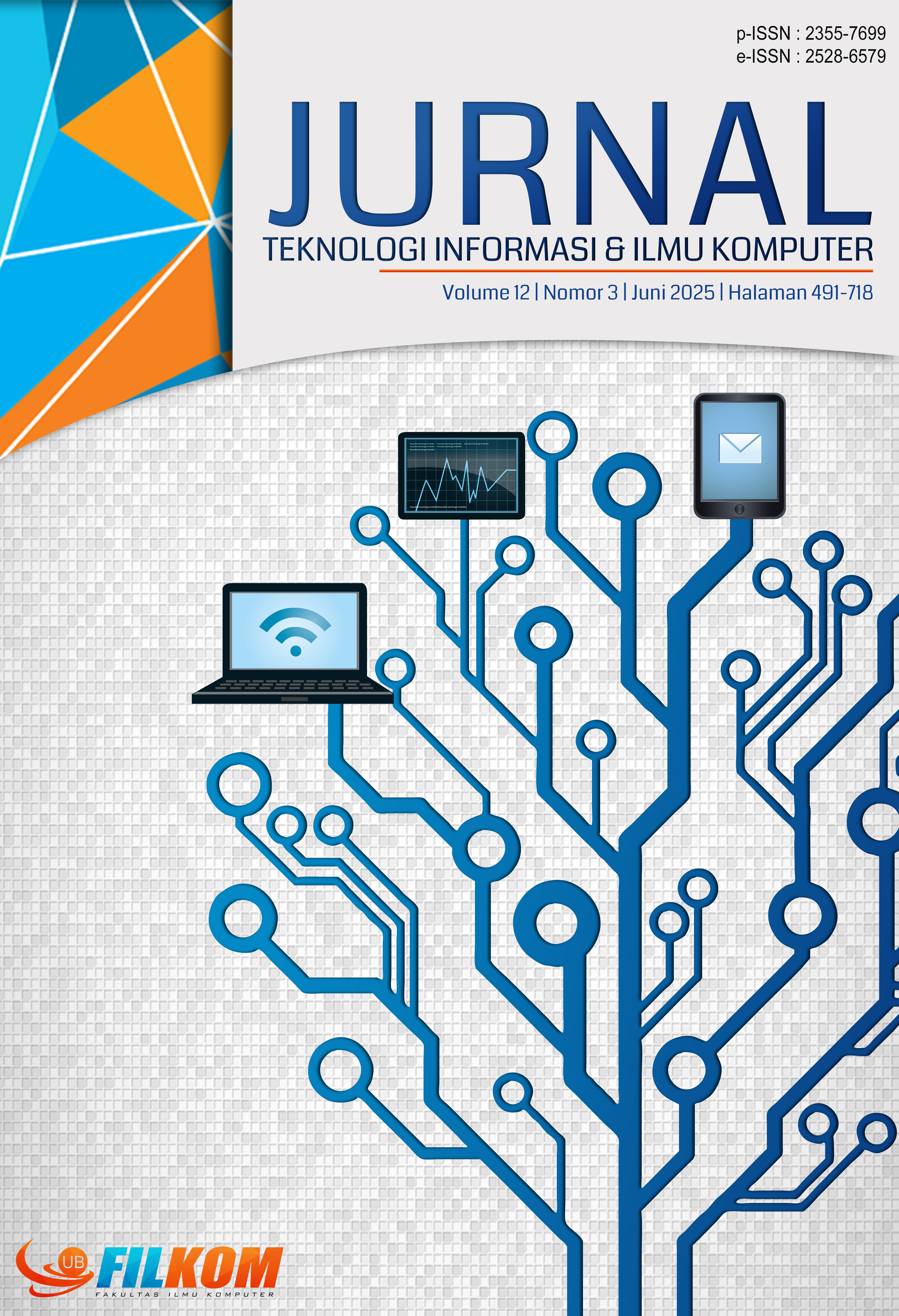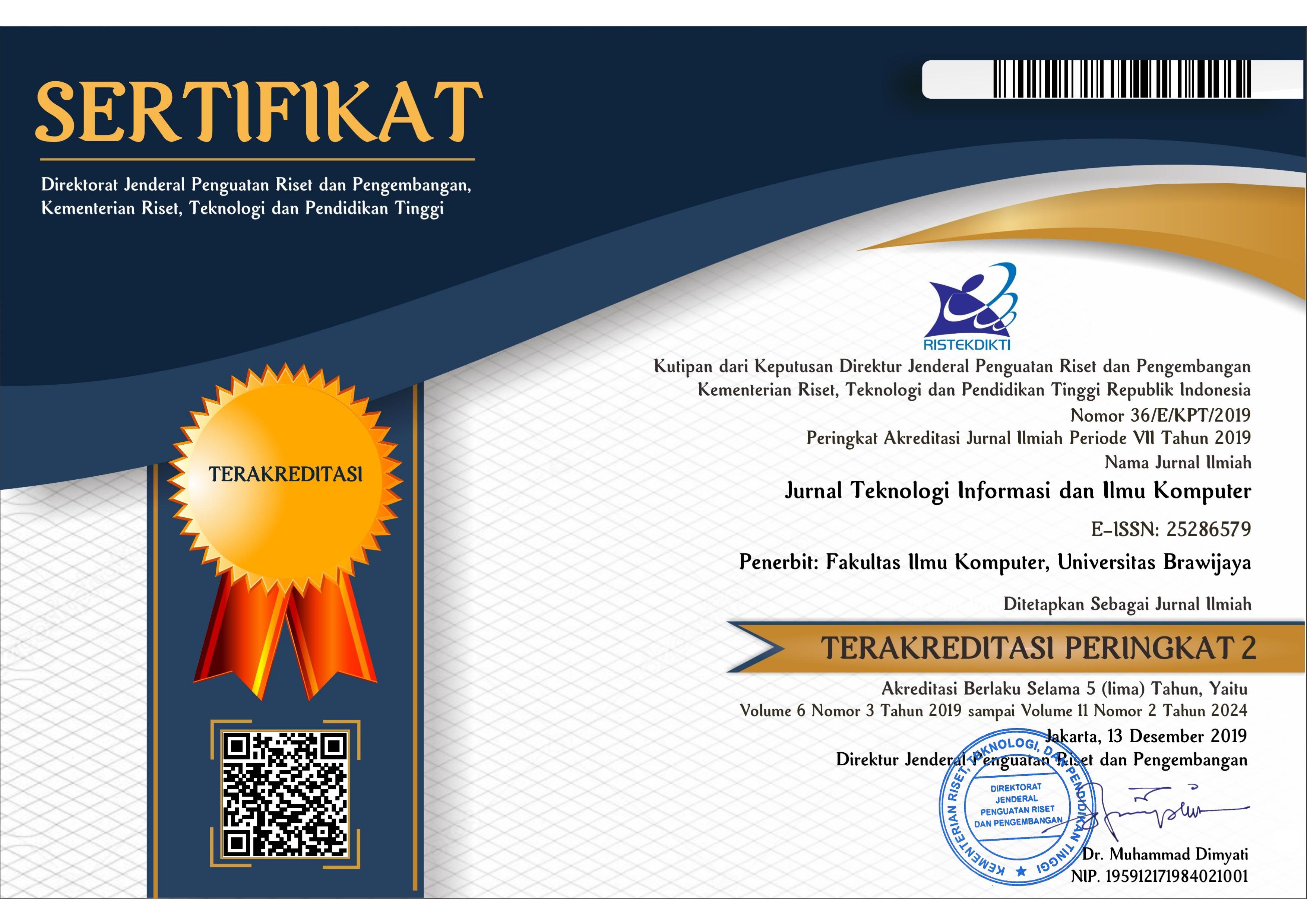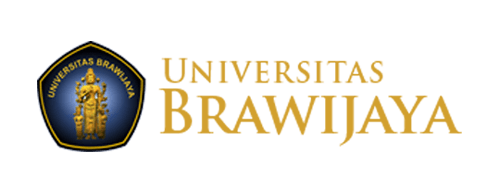Data Mining Pendidikan: Prediksi Gaya Belajar Mahasiswa Teknik Menggunakan Machine Learning
DOI:
https://doi.org/10.25126/jtiik.2025129190Kata Kunci:
Learning Style, Data Mining, Machine LearningAbstrak
Dalam platform online, pembelajar yang berbeda memiliki gaya belajar yang berbeda berdasarkan perilaku belajar. Oleh karena itu, menganalisis perilaku dan mendeteksi gaya belajar mahasiswa adalah penting untuk memberikan rekomendasi sumber daya yang tepat, sehingga meningkatkan hasil belajar mahasiswa. Untuk memprediksi gaya belajar mahasiswa, dihitung dan dibandingkan kinerja algoritma pembelajaran mesin seperti regresi logistik, pohon penentuan, K-Nearest neighbour, support vector machine, neural network, dan Naive Bayes. Dataset terdiri dari seratus mahasiswa teknik yang belajar Arsitektur Komputer selama satu semester. Studi berbasis data seperti ini sangat penting untuk membangun sistem analisis pembelajaran di institusi pendidikan tinggi dan membantu proses pengambilan keputusan. Hasilnya menunjukkan bahwa model yang disarankan mencapai akurasi klasifikasi sebesar 65–78% dengan hanya empat parameter digunakan: nilai akhir, predikat, program studi, dan jenis kelamin. Hasil menunjukkan bahwa algoritma K-Nearest Neighbour memiliki tingkat akurasi 78% tertinggi dibandingkan dengan algoritma machine learning lainnya. Ini menunjukkan bahwa ada korelasi yang signifikan antara data aktual dan data prediksi. Hasilnya menunjukkan bahwa 78% sampel diklasifikasikan dengan benar. Hasil empiris dari penelitian ini memungkinkan pemahaman yang lebih baik tentang proses penggalian data pendidikan perguruan tinggi saat ini. Pemahaman ini dapat digunakan untuk mempertimbangkan faktor-faktor yang perlu dipertimbangkan oleh para mahasiswa teknik saat membuat keputusan tentang proses pembelajaran.
Abstract
In online platforms, different learners have different learning styles based on learning behavior. Therefore, analyzing behavior and detecting student learning styles is important to provide appropriate resource recommendations, thereby improving student learning outcomes. To predict student learning styles, the performance of machine learning algorithms such as logistic regression, determination trees, K-Nearest neighbors, support vector machines, neural networks, and Naive Bayes are calculated and compared. The dataset consists of one hundred engineering students studying Computer Architecture for one semester. Data-based studies like this are essential for building learning analytics systems in higher education institutions and aiding decision-making processes. The results show that the proposed model achieves a classification accuracy of 65–78% with only four parameters used: final grade, predicate, study program, and gender. The results show that the K-Nearest Neighbor algorithm has the highest accuracy rate of 78% compared to other machine learning algorithms. This shows that there is a significant correlation between the actual data and the predicted data. The results show that 78% of the samples were classified correctly. The empirical results of this research enable a better understanding of the current process of mining higher education education data. This understanding can be used to consider factors that engineering students need to consider when making decisions about the learning process.
Downloads
Referensi
ABBAS, J. 2021. The impact of coronavirus (SARS-CoV2) epidemic on individuals mental health: The protective measures of Pakistan in managing and sustaining transmissible disease. Psychiatria Danubina. https://doi.org/10.24869/PSYD.2020.472
AHMAD MUHAMMAD, B., QI, C., WU, Z., & KABIR AHMAD, H. 2022. GRL-LS: A learning style detection in online education using graph representation learning. In Expert Systems with Applications. https://doi.org/10.1016/j.eswa.2022.117138
AISSAOUI, O. EL, EL MADANI, Y. E. A., OUGHDIR, L., & ALLIOUI, Y. EL. 2019. Combining supervised and unsupervised machine learning algorithms to predict the learners’ learning styles. Procedia Computer Science. https://doi.org/10.1016/j.procs.2019.01.012
ALSHANQITI, A., & NAMOUN, A. 2020. Predicting student performance and its influential factors using hybrid regression and multi-label classification. IEEE Access. https://doi.org/10.1109/ACCESS.2020.3036572
AQEEL, M., REHNA, T., SHUJA, K. H., & ABBAS, J. 2022. Comparison of Students’
Mental Wellbeing, Anxiety, Depression, and Quality of Life During COVID-19’s Full and Partial (Smart) Lockdowns: A Follow-Up Study at a 5-Month Interval. Frontiers in Psychiatry. https://doi.org/10.3389/fpsyt.2022.835585
ASISH, S. M., KULSHRESHTH, A. K., & BORST, C. W. 2022. Detecting distracted students in educational VR environments using machine learning on eye gaze data. Computers and Graphics (Pergamon), 109, 75–87. https://doi.org/10.1016/j.cag.2022.10.007
AULAKH, K., ROUL, R. K., & KAUSHAL, M. 2023. E-learning enhancement through educational data mining with Covid-19 outbreak period in backdrop: A review. In International Journal of Educational Development. https://doi.org/10.1016/j.ijedudev.2023.102814
AZADI, N. A., ZIAPOUR, A., LEBNI, J. Y., IRANDOOST, S. F., ABBAS, J., & CHABOKSAVAR, F. 2021. The effect of education based on health belief model on promoting preventive behaviors of hypertensive disease in staff of the Iran University of Medical Sciences. Archives of Public Health. https://doi.org/10.1186/s13690-021-00594-4
AZZI, I., JEGHAL, A., RADOUANE, A., YAHYAOUY, A., & TAIRI, H. 2020. A robust classification to predict learning styles in adaptive E-learning systems. Education and Information Technologies. https://doi.org/10.1007/s10639-019-09956-6
BERNARD, J., POPESCU, E., & GRAF, S. 2022. Improving online education through automatic learning style identification using a multi-step architecture with ant colony system and artificial neural networks. Applied Soft Computing. https://doi.org/10.1016/j.asoc.2022.109779
BIAO, Z. Z. 2023. Design and realization of data mining simulation and methodological models. Journal of King Saud University - Science, 35(10), 102964. https://doi.org/10.1016/j.jksus.2023.102964
BORHANI, K., & WONG, R. T. K. 2023. An artificial neural network for exploring the relationship between learning activities and students’ performance. Decision Analytics Journal, 9(September), 100332. https://doi.org/10.1016/j.dajour.2023.100332
CAPUANO, N., & TOTI, D. 2019. Experimentation of a smart learning system for law based on knowledge discovery and cognitive computing. Computers in Human Behavior. https://doi.org/10.1016/j.chb.2018.03.034
CHRISTODOULOU, E., MA, J., COLLINS, G. S., STEYERBERG, E. W., VERBAKEL, J. Y., & VAN CALSTER, B. 2019. A systematic review shows no performance benefit of machine learning over logistic regression for clinical prediction models. In Journal of Clinical Epidemiology. https://doi.org/10.1016/j.jclinepi.2019.02.004
DAKE, D. K., & BUABENG-ANDOH, C. 2022. Using Machine Learning Techniques to Predict Learner Drop-out Rate in Higher Educational Institutions. Mobile Information Systems. https://doi.org/10.1155/2022/2670562
DEEVA, G., DE SMEDT, J., SAINT-PIERRE, C., WEBER, R., & DE WEERDT, J. 2022. Predicting student performance using sequence classification with time-based windows. Expert Systems with Applications. https://doi.org/10.1016/j.eswa.2022.118182
EL AISSAOUI, O., EL MADANI EL ALAMI, Y., OUGHDIR, L., & EL ALLIOUI, Y. 2018. Integrating web usage mining for an automatic learner profile detection: A learning styles-based approach. 2018 International Conference on Intelligent Systems and Computer Vision, ISCV 2018. https://doi.org/10.1109/ISACV.2018.8354021
EL AISSAOUI, O., OUGHDIR, L., & EL ALLIOUI, Y. 2022. A Literature Review on Student Modeling Purposes. https://doi.org/10.1007/978-3-030-90633-7_64
FARHANA, S. 2021. Classification of Academic Performance for University Research Evaluation by Implementing Modified Naive Bayes Algorithm. Procedia Computer Science, 194, 224–228. https://doi.org/10.1016/j.procs.2021.10.077
FERNANDES, E., HOLANDA, M., VICTORINO, M., BORGES, V., CARVALHO, R., & ERVEN, G. VAN. 2019. Educational data mining: Predictive analysis of academic performance of public school students in the capital of Brazil. Journal of Business Research. https://doi.org/10.1016/j.jbusres.2018.02.012
FERREIRA, L. D., SPADON, G., CARVALHO, A. C., & RODRIGUES, J. F. 2018. A comparative analysis of the automatic modeling of Learning Styles through Machine Learning techniques. Proceedings - Frontiers in Education Conference, FIE. https://doi.org/10.1109/FIE.2018.8659191
GARG, A. 2020. Online Education: A Learner’s Perspective During COVID-19. Asia-Pacific Journal of Management Research and Innovation. https://doi.org/10.1177/2319510x211013594
HELAL, S., LI, J., LIU, L., EBRAHIMIE, E., DAWSON, S., MURRAY, D. J., & LONG, Q. 2018. Predicting academic performance by considering student heterogeneity. Knowledge-Based Systems. https://doi.org/10.1016/j.knosys.2018.07.042
KLEMENT, M. 2014. How do my Students Study? An Analysis of Students’ of Educational Disciplines Favorite Learning Styles According to VARK Classification. Procedia - Social and Behavioral Sciences. https://doi.org/10.1016/j.sbspro.2014.04.326
LARA, J. A., LIZCANO, D., MARTÍNEZ, M. A., PAZOS, J., & RIERA, T. 2014. A system for knowledge discovery in e-learning environments within the European Higher Education Area - Application to student data from Open University of Madrid,
UDIMA. Computers and Education. https://doi.org/10.1016/j.compedu.2013.10.009
MADUSHANI, J. P. S. S., SANDAMAL, R. M. K., MEDDAGE, D. P. P., PASINDU, H. R., & GOMES, P. I. A. 2023. Evaluating expressway traffic crash severity by using logistic regression and explainable & supervised machine learning classifiers. Transportation Engineering, 13(April), 100190. https://doi.org/10.1016/j.treng.2023.100190
MUHAJIR, D., AKBAR, M., BAGASKARA, A., & VINARTI, R. 2021. Improving classification algorithm on education dataset using hyperparameter tuning. Procedia Computer Science. https://doi.org/10.1016/j.procs.2021.12.171
NOURI, J., SAQR, M., & FORS, U. 2019. Predicting performance of students in a flipped classroom using machine learning: Towards automated data-driven formative feedback. ICSIT 2019 - 10th International Conference on Society and Information Technologies, Proceedings, January 2022, 79–82.
PARDAMEAN, B., SUPARYANTO, T., CENGGORO, T. W., SUDIGYO, D., & ANUGRAHANA, A. 2022. AI-Based Learning Style Prediction in Online Learning for Primary Education. IEEE Access. https://doi.org/10.1109/ACCESS.2022.3160177
PECUCHOVA, J., & DRLIK, M. 2023. Predicting Students at Risk of Early Dropping Out from Course Using Ensemble Classification Methods. Procedia Computer Science, 225, 3223–3232. https://doi.org/10.1016/j.procs.2023.10.316
PRADHAN, D., SAHOO, B., MISRA, B. B., & PADHY, S. 2020. A multiclass SVM classifier with teaching learning based feature subset selection for enzyme subclass classification. Applied Soft Computing Journal. https://doi.org/10.1016/j.asoc.2020.106664
PRASHANTH KUMAR, K. N., HARISH KUMAR, B. T., & BHUVANESH, A. 2024. Spectral clustering algorithm based web mining and quadratic support vector machine for learning style prediction in E-learning platform. Measurement: Sensors, 31(June 2023), 100962. https://doi.org/10.1016/j.measen.2023.100962
RASHEED, F., & WAHID, A. 2021. Learning style detection in E-learning systems using machine learning techniques. Expert Systems with Applications. https://doi.org/10.1016/j.eswa.2021.114774
RONG, L. J. 2022. Distance learning quality assessment of universities based on interval monotonic decision tree algorithm. Computers and Electrical Engineering. https://doi.org/10.1016/j.compeleceng.2022.108116
SHORFUZZAMAN, M., HOSSAIN, M. S., NAZIR, A., MUHAMMAD, G., & ALAMRI, A. 2019. Harnessing the power of big data analytics in the cloud to support learning analytics in mobile learning environment. Computers in Human Behavior. https://doi.org/10.1016/j.chb.2018.07.002
SU, Z., MCDONNELL, D., WEN, J., KOZAK, M., ABBAS, J., ŠEGALO, S., LI, X., AHMAD, J., CHESHMEHZANGI, A., CAI, Y., YANG, L., & XIANG, Y. T. 2021. Mental health consequences of COVID-19 media coverage: the need for effective crisis communication practices. In Globalization and Health. https://doi.org/10.1186/s12992-020-00654-4
TROUSSAS, C., CHRYSAFIADI, K., & VIRVOU, M. 2021. Personalized tutoring through a stereotype student model incorporating a hybrid learning style instrument. Education and Information Technologies. https://doi.org/10.1007/s10639-020-10366-2
TUAHA, S., SIDDIQUI, I. F., & ALI ARAIN, Q. 2019. Analyzing Students’ Academic Performance through Educational Data Mining. 3C Tecnología Glosas de Innovación Aplicadas a La Pyme. https://doi.org/10.17993/3ctecno.2019.specialissue2.402-421
VIBERG, O., HATAKKA, M., BÄLTER, O., & MAVROUDI, A. 2018. The current landscape of learning analytics in higher education. In Computers in Human Behavior. https://doi.org/10.1016/j.chb.2018.07.027
WAHEED, H., HASSAN, S. U., ALJOHANI, N. R., HARDMAN, J., ALELYANI, S., & NAWAZ, R. 2020. Predicting academic performance of students from VLE big data using deep learning models. Computers in Human Behavior. https://doi.org/10.1016/j.chb.2019.106189
XU, K., & SUN, Z. 2023. Predicting academic performance associated with physical fitness of primary school students using machine learning methods. In Complementary Therapies in Clinical Practice. https://doi.org/10.1016/j.ctcp.2023.101736
YAĞCI, M. 2022. Educational data mining: prediction of students’ academic performance using machine learning algorithms. Smart Learning Environments. https://doi.org/10.1186/s40561-022-00192-z
Unduhan
Diterbitkan
Terbitan
Bagian
Lisensi
Hak Cipta (c) 2025 Jurnal Teknologi Informasi dan Ilmu Komputer

Artikel ini berlisensiCreative Commons Attribution-ShareAlike 4.0 International License.

Artikel ini berlisensi Creative Common Attribution-ShareAlike 4.0 International (CC BY-SA 4.0)
Penulis yang menerbitkan di jurnal ini menyetujui ketentuan berikut:
- Penulis menyimpan hak cipta dan memberikan jurnal hak penerbitan pertama naskah secara simultan dengan lisensi di bawah Creative Common Attribution-ShareAlike 4.0 International (CC BY-SA 4.0) yang mengizinkan orang lain untuk berbagi pekerjaan dengan sebuah pernyataan kepenulisan pekerjaan dan penerbitan awal di jurnal ini.
- Penulis bisa memasukkan ke dalam penyusunan kontraktual tambahan terpisah untuk distribusi non ekslusif versi kaya terbitan jurnal (contoh: mempostingnya ke repositori institusional atau menerbitkannya dalam sebuah buku), dengan pengakuan penerbitan awalnya di jurnal ini.
- Penulis diizinkan dan didorong untuk mem-posting karya mereka online (contoh: di repositori institusional atau di website mereka) sebelum dan selama proses penyerahan, karena dapat mengarahkan ke pertukaran produktif, seperti halnya sitiran yang lebih awal dan lebih hebat dari karya yang diterbitkan. (Lihat Efek Akses Terbuka).








